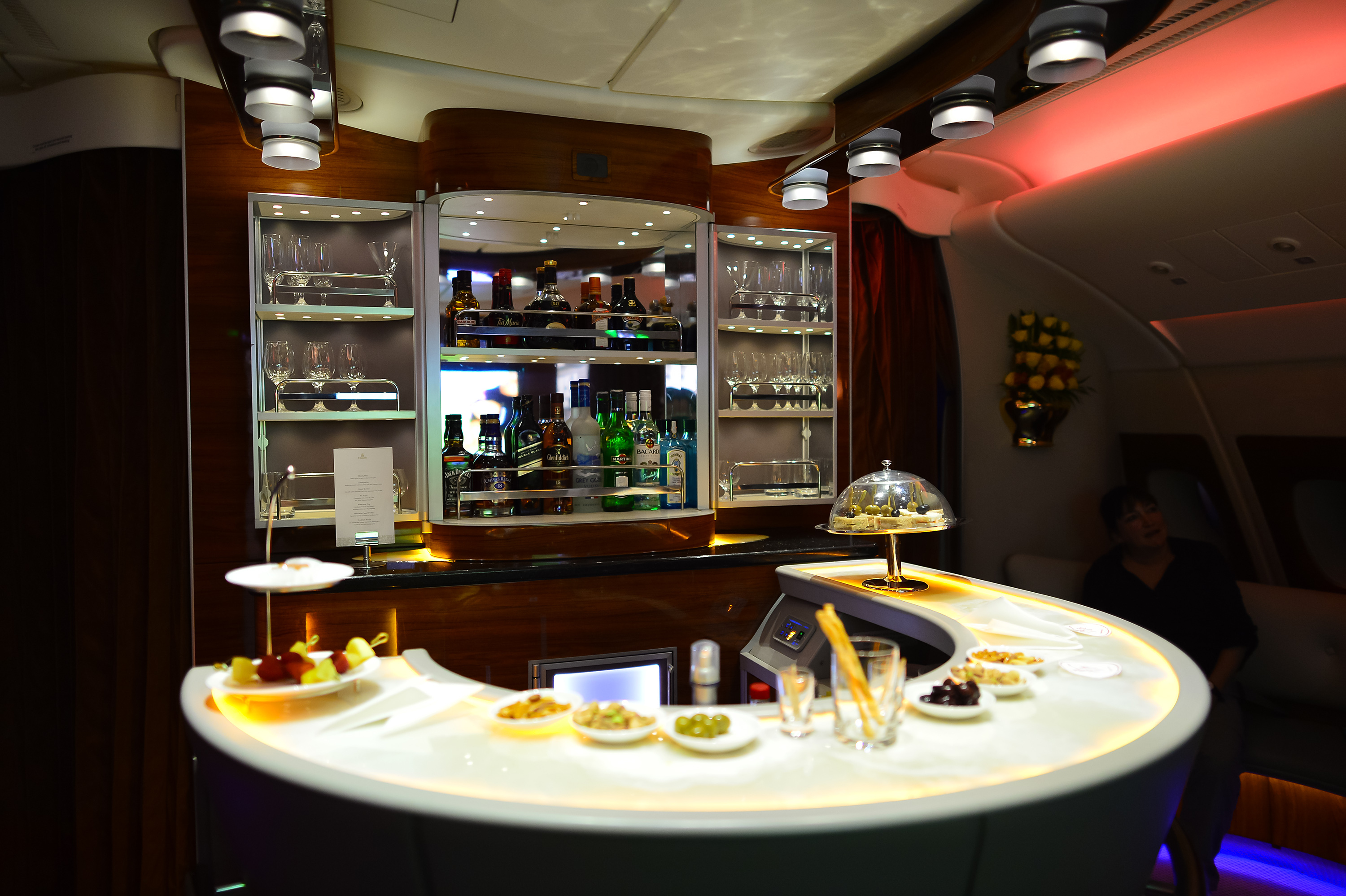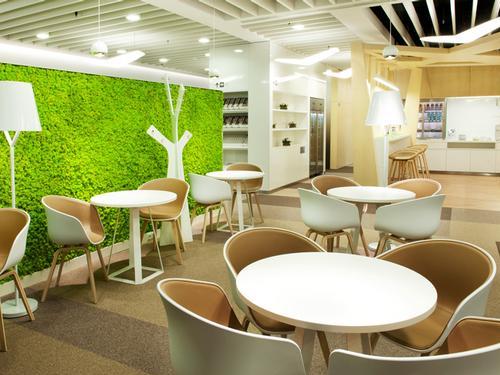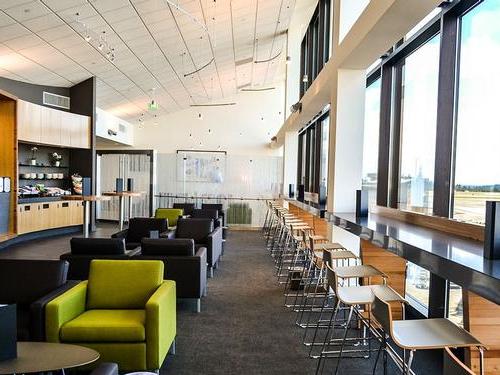Look back, relax and enjoy your lounge
Comfort, class and exclusivity were once the distinctive service qualities of airlines during the so-called golden years of air travel, namely the period before airline deregulation in the late 1970s. Back then, airlines that flew the Boeing 747 jumbo jet had the option to include luxuries such as a piano bar and lounge, or some other respite from the other passengers on the upper deck of their brand new aircraft.
Those times have taken a one-way ticket to aviation history, but there remain some exceptions among airlines looking to lure the well-heeled flyer. Still, the luxuries are almost always limited to high-paying first class passengers and appear to add more to an airline’s reputation and brand than its bottom line.
Most airlines today look to the ground to provide a similar VIP experience. Enter the airport lounge—an idea started by airlines to continue passenger perks after deregulation to win customer loyalty and now expanded to accommodate just about every type of Traveller. You might be surprised to learn that the history of the airport lounge goes back to 1939. That’s when American Airlines introduced the Admirals Club at New York Municipal Airport, now LaGuardia Airport in the borough of Queens. Created as a marketing tool for improving customer service and increasing brand loyalty, the airport lounge concept took off and became a brand extension for many airlines.
There were familiar names like Clipper Club (Pan American), Ambassadors Club (Trans World Airlines and Ionosphere Club (Eastern Air Lines). Though most of these airlines have disappeared, the appeal of the airport club continues. In fact, the battle is intensifying with airlines and independent companies now vying for dominance in an intensely competitive field with space only as big as airports will allow. If you’re reading this from the comfort of an airport lounge, know that it’s been quite a journey to get you into that seat.
The democratization of airline service around the world over the last several decades has led to an unprecedented increase in passengers. If you’ve wondered, even groused, at the sheer size of the crowds at airports recently, this probably isn’t news to you. According to the International Air Transport Association (IATA), 7.2 billion passengers are expected to take to the skies by 2035. That’s nearly double the number of passengers that flew in 2016.
Numerous airports in the oldest aviation markets like North America and Europe find themselves stretched to the seams, but steadily, improvements are being made to accommodate the burgeoning passenger population, especially when it comes to places for passengers to shop, dine or simply relax.
For decades, airlines had been the main players in the airport lounge experience. Once exclusively for premium Travellers, the clubs became accessible to any airline frequent flyer willing to buy an annual membership. Today, there are single-use passes that can be purchased and access is granted to certain members of partner airlines, depending on itinerary and frequent flyer status.
Despite the expanding qualifications to enter a club over the years, the airline lounges have largely remained exclusive to their paying members, or to a limited number of affiliated guests and flyers in premium cabins. Even with this selectivity, there has always been some lament over the expansion of privileges to those beyond premium cabins. Case in point is an article written back in 1982 for The New York Times. You’ll likely be amused by the prices for lounge access back then as well as the modest amenities. What this article also shows is that the landscape was changing back then too. Fast-forwarding to 2017, the lounge business is much different, even if the primary goal has remained the same: to provide a space for members to work, decompress and enjoy a level of exclusivity shielded from the stress of travel.
The declassification of lounge access
Today, there are lounges for all tastes and levels of distinctiveness and the ways to gain access are numerous. An article in Airport Business published by aviationpros.com notes that the emergence of non-airline airport lounges was spurred on by several factors. Among them was the available real estate, some of which was yielded by the airlines themselves because of mergers, operational reductions or financial reasons. Another factor was the increasing amount of time passengers were spending at airport terminals, in large part due to added security measures—a factor that is cited today as a major contributor to travel stress. It was 25 years ago that Priority PassTM, part of the travel marketing leader Collinson Group, set out to democratize Traveller access to airport lounges. The unique appeal of Priority Pass has been its availability to flyers in any class of service on any airline. Now with more than 1,000 lounges around the world in its network, Priority Pass offers members more places to stretch out, eat and relax than ever before.
In short, the ability to mitigate the stress and rigors of air travel has become available to more Travellers than at any time in aviation history thanks to the pioneering efforts of companies like Priority Pass.
Twenty five years later, the current “loungescape” looks very different from years ago. There are not only airline-specific lounges, but the business model has evolved into one of partnerships and shared benefits.
For instance, it might be costly for an airline to maintain a lounge at an airport when it only has one or two flights a day, but by partnering with another company or airline, its passengers could have access to a shared lounge. Some credit card companies and other businesses also offer lounge access for their customers by partnering with airlines and independent lounge companies like Priority Pass. No longer is it necessary to fly on a specific airline or carry a first class boarding pass to gain access to the stress-free environment of an airport lounge.
The independent lounge concept introduces an added level and abundant option: the declassification, if you will, of the entry-by-status model. By that we mean that class of service in the air does not determine your entry on the ground.
Still, airlines continue to cater to their high-paying customers by providing exclusivity for their First Class flyers. This is the one domain where they aim to reign supreme. Catering to premium flyers has been the inspiration for lounges since their inception, as exemplified by the British Airways Concorde Room which featured a separate boarding access directly to the famous supersonic aircraft. The concept is alive and well with some carriers offering entire terminals to their First Class passengers, along with separate VIP escorts directly to the aircraft, sometimes via limousine. It’s clear that as the growth of airport lounges continues, many airlines still seek to differentiate themselves by continuing a level of exclusivity for their highest paying customers.
In an interview with Airport Business, Nancy Knipp, senior vice president at Airport Lounge Development (ALD), also a Collinson Group company, stated why the demand has been increasing for independent lounges, particularly in the U.S. “The airlines dominated the lounge industry for years. But as they make changes, they are becoming a lot more exclusive when it comes to who gets into their lounges,” Knipp said. “They are making a lot more investment in their lounges, and that investment has really driven them to try and differentiate the experience for their most important customers. The airlines are becoming a lot more exclusive in deciding who gets in.”
Lounge Amenity Explosion
As lounge popularity grows, so does the range of amenities in an effort to maintain loyalty. There are several players in the independent lounge game, including credit card companies. American Express Centurion lounges, a complimentary benefit for elite cardholders and paid access for other cardholders, dot the airport landscape in several airports across the United States. There are also boutique style lounges cropping up at key international gateways that charge hourly or a fixed price for a limited visit. The Plaza Premium Lounge network (whose London Heathrow lounge was recognized at the Lounge of the Year by Priority Pass Members) also provides access to independent and airline-shared lounges. But the so-called lounge wars are more of a positioning game than a battle. The advantage of companies like Priority Pass is in their ability to balance a wide-ranging appeal to any Traveller in any class, while still maintaining a sense of exclusivity for savvy flyers who seek solace from boisterous airport terminals.
Countries in fast-growing aviation markets in Asia and the Middle East have invested in passenger-centric terminals of the future, featuring modern and technologically advanced settings that attract the high-paying passenger as well as the flyer lacking elite status. Airports throughout the rest of the world are getting into the game as well. Airlines have invested in upgrades to their spaces and amenities while independently-operated lounges have grown from occasional airport terminal outcrops to alluring alternatives to the single-airline clubs.
And just as air travel was democratized in the 1970s with airline deregulation, companies like Priority Pass have essentially “declassified” the secrets to offering a VIP experience away from travel stress regardless of airline or class of travel. It’s the great equalizer, and perhaps the great advantage for those seeking a way to get away.
As the 747 is remembered for its halcyon days and the A380 is revered for what premium passengers still get to enjoy in the air, the majority of flyers, seeking relief from the stresses of everyday travel, are keeping their eyes on the ground. With a membership card in their pockets and their digital devices, they know that a good flight indeed begins before takeoff, and a comfortable seat, a great view and the freedom to do as much or as little as the moment calls for is the best way to embrace the new age of travel.
Links:
http://www.cnn.com/2016/02/16/aviation/airport-lounges-business-traveller/
http://www.nytimes.com/1982/10/10/travel/practical-Traveller-not-so-exclusive-vip-lounges.html
http://www.aviationpros.com/article/12226663/a-new-level-of-passenger-comfort




